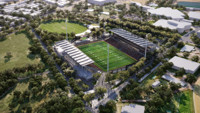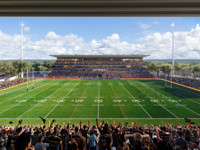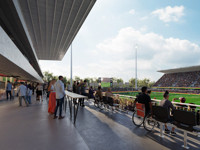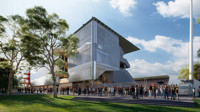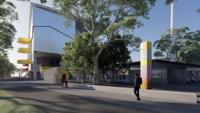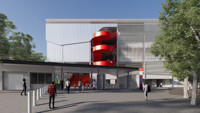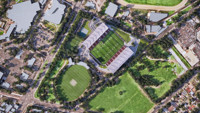Penrith Stadium
| Capacity | 25 000 |
|---|---|
| Country | Australia |
| City | Penrith |
| Clubs | Penrith Panthers |
| Category | Design being implemented |
| Cost | A$309 M ($204 M) |
| Construction | 2025–2026 |
| Design | Populous, Tyrrell Studio |
| Contractor | John Holland Group |
Advertisement
Penrith Stadium – design description
What does the redevelopment project of Penrith Stadium look like in brief?
Although the redevelopment plan for Penrith Stadium involves a complete demolition and the construction of an entirely new arena, the venue’s traditional character will be retained – with tall grandstands along the sidelines and grassy embankments behind the goals, where spectators will also be able to watch the games.
The new stadium will accommodate 25,000 spectators, slightly more than the previous 22,500, and its facilities will be brought up to modern standards. The design has been prepared by the renowned international architecture firm Populous together with local practice Tyrrell Studio.
Located in the far western suburbs of Sydney, Penrith Stadium is above all the home of the Penrith Panthers, the rugby league team that won four consecutive premierships between 2021 and 2024 in the world’s most prestigious rugby league competition, the National Rugby League.
The old stands were demolished between April and August 2025, after which construction work on the new facility began. Completion is expected in 2026, so that the stadium will be ready in time for the start of the 2027 season.
What did the former Penrith Stadium look like?
Penrith Stadium was opened in April 1967. At first, it featured an oval playing field and a modest grandstand on the western side. The stadium was completely transformed in the 1980s, when the pitch was converted to a rectangular layout and new stands were built along the sidelines. In 2006, the western grandstand was further expanded.
After the last expansion, the stadium consisted of two stands – the western grandstand (with corporate boxes) and the eastern stand. Behind the goals were grassy embankments, also used by spectators. The venue was equipped with floodlights and had a capacity of 22,500.
It served as the principal stadium of Penrith – a distant western suburb of Sydney, located more than 50 km from the city’s central business district. Due to naming-rights agreements, the ground was known under different names, the last of which, from 2021, was BlueBet Stadium.
The main tenant of Penrith Stadium was the rugby league team Penrith Panthers, competing in the National Rugby League (NRL). In its final years, the team achieved outstanding success, winning four consecutive premierships from 2021 onwards.
When were the plans to redevelop Penrith Stadium made?
Concrete reports about the planned redevelopment of Penrith Stadium emerged in mid-2021. The investment was to be carried out by the New South Wales Government, reallocating part of the funds from the abandoned redevelopment of Stadium Australia. In April and May 2022, the first public consultations on the matter were held.
In mid-2022, a new idea was floated – instead of redeveloping Penrith Stadium, a completely new venue would be built on the site of the nearby horse racing track, Penrith Paceway. However, after the state government changed in March 2023, the earlier plans were revived.
In January 2024, the New South Wales Government released renderings and provided the first details of the planned redevelopment. The design of the new Penrith Stadium was prepared by the renowned international firm Populous, in cooperation with the local Tyrrell Studio.
What are the main features of the Penrith Stadium redevelopment?
The plan calls for the demolition of the existing Penrith Stadium and the construction of a new venue on the same site, though in a relatively similar form – the venue will feature two high stands along the field, while the gentle grassy hills on the northern and southern ends will be retained.
The new stands will have a much steeper angle, ensuring better sightlines. Their upper sections will be covered, and the western stand will host a significant number of premium seats. New floodlight masts will rise in the corners, and larger video screens will be placed behind the goals.
The stadium will also have more food and beverage outlets, additional restrooms, and be equipped with the latest technologies. Compared to its predecessor, capacity will increase from 22,500 to 25,000 spectators (for concerts, the stadium will be able to hold up to 30,000 people).
The project also focuses on the training field located behind the western stand, which will be converted into an open recreational and training area. Changes will extend to the entire stadium surroundings, including new entrances and fencing.
Who will the new Penrith Stadium serve?
After the redevelopment, the main tenant of the stadium will continue to be the Penrith Panthers. The venue will also be suitable for hosting other major rugby and football games, as well as large cultural events.
When will the new Penrith Stadium be completed?
On 13 September 2024, the Penrith Panthers played their last home game at the old stadium. For the next two seasons, the team will play at other venues, primarily at CommBank Stadium.
In October 2024, the first preparatory works began, including the relocation of a major sewer main beneath the western grandstand, an important part of the sewer network in Sydney’s western suburbs.
In early March 2025, it was announced that John Holland Group would be the main contractor for the redevelopment. Official construction work commenced on 17 April 2025. Between April and August 2025, the old stands were demolished.
At the end of August 2025, the main construction phase began, and new renderings were also released. The construction of the new stadium is scheduled to be completed in 2026 so that the venue will be ready for the start of the 2027 season.
Updates on the Penrith Stadium redevelopment can be viewed on a dedicated webpage
How much will the Penrith Stadium redevelopment cost?
The investment is expected to cost AUD 309 million and will be financed by the New South Wales Government.
Advertisement

 StadiumDB
StadiumDB